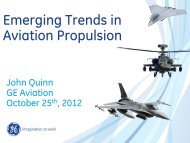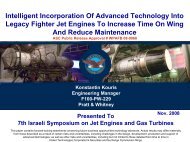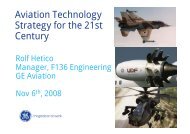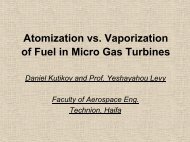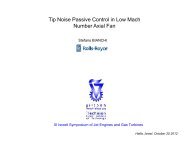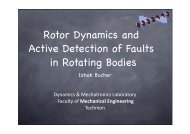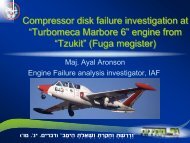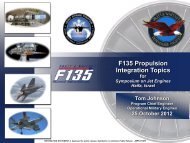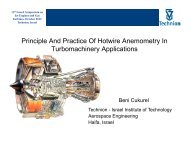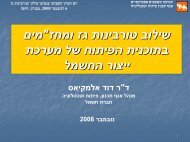Recuperator Design for 90kw Turboprop/Turboshaft - Turbo & Jet ...
Recuperator Design for 90kw Turboprop/Turboshaft - Turbo & Jet ...
Recuperator Design for 90kw Turboprop/Turboshaft - Turbo & Jet ...
Create successful ePaper yourself
Turn your PDF publications into a flip-book with our unique Google optimized e-Paper software.
R-<strong>Jet</strong> Engineering Ltd<br />
<strong>Recuperator</strong> <strong>Design</strong> <strong>for</strong> <strong>90kw</strong> <strong><strong>Turbo</strong>prop</strong>/<strong><strong>Turbo</strong>shaft</strong><br />
David Lior<br />
Contents<br />
1. Requirements-Solutions<br />
2. Mission analysis <strong>for</strong> optimum engine design.<br />
3. <strong>Recuperator</strong>s types<br />
4. <strong>Recuperator</strong>s per<strong>for</strong>mance effect on gas turbine per<strong>for</strong>mance ,size and weight.<br />
5. Off <strong>Design</strong> Per<strong>for</strong>mance of aerospace recuperators<br />
6. Optimization of recuperator design to match aircraft mission.<br />
7. Conclusions.<br />
1<br />
1
R-<strong>Jet</strong> Engineering Ltd<br />
<strong>Recuperator</strong> <strong>Design</strong> <strong>for</strong> <strong>90kw</strong> <strong><strong>Turbo</strong>prop</strong>/<strong><strong>Turbo</strong>shaft</strong><br />
Engine Requirements:<br />
1. Power - why <strong>90kw</strong>? - the UAV market<br />
2 . Long endurance [48 hours] - dictating low fuel consumption<br />
3. Technical requirements:<br />
a. Compactness - (shape and size).<br />
b. Weight - dry weight + fuel weight per mission<br />
c. Fuel type [kerosene, diesel 2].<br />
d. Reliability.<br />
e. Life cycle cost.<br />
f. Emissions.<br />
2<br />
g. Availability- Manufacturing in Israel.<br />
2
R-<strong>Jet</strong> Engineering Ltd<br />
Recuperation concept<br />
The Recuperated Cycle:<br />
1. Method:<br />
The compressor out flow is directed through a heat exchanger be<strong>for</strong>e flowing to the<br />
Combustor;<br />
The turbine exit hot flow is exhausted through the heat exchanger to heat the<br />
compressor out flow;<br />
The heated compressor out flow air is supplied to the combustor thus saving fuel.<br />
2. Application:<br />
In low pressure ratio cycle gas turbine - the exhaust temperature should be higher<br />
than the compressor outlet temperature.<br />
3. Experience:<br />
At present limited to ground applications due to its high weight<br />
3<br />
3
R-<strong>Jet</strong> Engineering Ltd<br />
<strong>Recuperator</strong>/Regenerator Evaluation<br />
1. <strong>Recuperator</strong> - a static heat exchanger in which 2 matrixes exist<br />
Pressure drops in matrixes and engine ducting<br />
Weight - 1.25 Kg/kW engine power - 85% effectiveness<br />
2. Regenerator - a rotating heat exchanger having 1 matrix<br />
For same effectiveness of 85%:<br />
Lower pressure drops due to smaller thickness.<br />
Weight - 0.25 Kg/kW engine power.<br />
Problem - gas leakages - about 5%.<br />
4<br />
4
R-<strong>Jet</strong> Engineering Ltd<br />
5<br />
5
R-<strong>Jet</strong> Engineering Ltd<br />
6<br />
6
R-<strong>Jet</strong> Engineering Ltd<br />
7<br />
7
R-<strong>Jet</strong> Engineering Ltd<br />
Regenerator<br />
8<br />
8
R-<strong>Jet</strong> Engineering Ltd<br />
<strong>Recuperator</strong> Integration in Gas Turbine <strong>Design</strong><br />
9<br />
9
R-<strong>Jet</strong> Engineering Ltd<br />
<strong><strong>Turbo</strong>prop</strong> recuperated cycle<br />
10<br />
10
R-<strong>Jet</strong> Engineering Ltd<br />
<strong>Recuperator</strong> <strong>Design</strong> <strong>for</strong> 90kW <strong><strong>Turbo</strong>prop</strong>/<strong><strong>Turbo</strong>shaft</strong><br />
Solutions<br />
a. None recuperated High Compression Ratio [10:1] may achieve<br />
20% Thermal Efficiency due to low adiabatic efficiencies of -<br />
2 Stages centrifugal compressors<br />
3 Stages axial turbines - [none cooled]<br />
Weight- 45Kg - including transmission<br />
Cost- 90,000$ - [estimation-none available]<br />
b. None recuperated compression ratio [5:1] may achieve<br />
18% thermal efficiency with<br />
1 Stage compressor and 1 stage turbine<br />
Weight – 40Kg including transmission<br />
11<br />
Cost- 60000$ including transmission<br />
11
R-<strong>Jet</strong> Engineering Ltd<br />
<strong>Recuperator</strong> <strong>Design</strong> <strong>for</strong> <strong>90kw</strong> <strong><strong>Turbo</strong>prop</strong>/<strong><strong>Turbo</strong>shaft</strong><br />
c. Reciprocating piston engine – 90kW<br />
Thermal efficiency - 30%<br />
Weight -80Kg<br />
Cost – 80,000$<br />
d. Rotary piston engine - 90kW [none available ]<br />
Thermal efficiency - 30%<br />
Weight – 60Kg<br />
Cost – 60,000$<br />
e. Recuperated low compression ratio [4:1]<br />
thermal efficency - 34%<br />
1 stage compressor -1 stage turbine<br />
Weight – 72Kg<br />
Cost – 85,000$<br />
12<br />
12
R-<strong>Jet</strong> Engineering Ltd<br />
Rotax 914F PISTON ENGINE<br />
13<br />
13
R-<strong>Jet</strong> Engineering Ltd<br />
<strong>Recuperator</strong> <strong>Design</strong> <strong>for</strong> <strong>90kw</strong> <strong><strong>Turbo</strong>prop</strong>/<strong>Turbo</strong> shaft<br />
Engines comparison<br />
ROTAX<br />
GT90<br />
Power 100hp 120hp<br />
Frontal area - sqm 0.3 0.2<br />
Length- m 0.6 0.78<br />
Weight- kg 80 72<br />
power/weight 1.25 1.68<br />
S.F.C-gr/hp hr 212 180<br />
14<br />
14
R-<strong>Jet</strong> Engineering Ltd<br />
<strong>Recuperator</strong> <strong>Design</strong> <strong>for</strong> 90KW <strong><strong>Turbo</strong>prop</strong>/<strong><strong>Turbo</strong>shaft</strong><br />
Mission analysis <strong>for</strong> optimum engine design<br />
Assumption:- continuous operating point at altitude of 20,000ft<br />
Mach=0.3 Endurance – variable<br />
Engine SFC Power Fuel Engine total Endurance<br />
gr/hphr hp Kg Kg Kg hrs<br />
Recuperated * 180 35 71 72 143 12<br />
Recuperated** 170 35 23 120 143 4<br />
Piston 212 35 63 80 143 8.5<br />
G.T – not<br />
Recuperated<br />
340 35 98 45 143 8<br />
* <strong>Recuperator</strong> weight – 28 kG – optimized <strong>for</strong> mission<br />
** recuperator weight – 74Kg optimized <strong>for</strong> SLS conditions<br />
15<br />
15
R-<strong>Jet</strong> Engineering Ltd<br />
GT-90 kW - Weight Estimation<br />
Item<br />
Basic Gas Turbine<br />
Weight<br />
16 Kg<br />
Transmission<br />
15 Kg<br />
Oil & Fuel Systems<br />
5 Kg<br />
<strong>Recuperator</strong><br />
28 Kg<br />
Starter & Miscellaneous<br />
4 Kg<br />
Engine Rake & Housing<br />
4 Kg<br />
Total Weight<br />
72 Kg<br />
16
R-<strong>Jet</strong> Engineering Ltd<br />
Endurance of Engines types<br />
70<br />
60<br />
large recuperator<br />
small recuperator<br />
Piston<br />
none recuprated G.T<br />
50<br />
40<br />
Pisto<br />
30<br />
20<br />
Endurance hours<br />
Fuel+Engine Weight kg<br />
10<br />
143<br />
250<br />
350<br />
450<br />
0<br />
17<br />
17
R-<strong>Jet</strong> Engineering Ltd<br />
<strong>Recuperator</strong> <strong>Design</strong> <strong>for</strong> 90kW <strong><strong>Turbo</strong>prop</strong>/<strong>Turbo</strong> shaft<br />
SlS<br />
per<strong>for</strong>mance<br />
NTU=2.5<br />
EFF.=70%<br />
7500m<br />
per<strong>for</strong>mance<br />
NTU=6<br />
Eff.=85%<br />
18<br />
18
R-<strong>Jet</strong> Engineering Ltd<br />
Compact <strong>Recuperator</strong> <strong>Design</strong> Solution <strong>for</strong> Part Load<br />
<strong>Design</strong> a small efficient recuperator <strong>for</strong> mission profile conditions<br />
METHOD - Take advantage of the reduced airflows at part load , mainly at<br />
altitude and low Mach number conditions and optimize the design<br />
accordingly.<br />
• The off design point is the SLS conditions<br />
• The reduced flow - 40% of max. flow- at altitude of 7500m allows about same<br />
reduction of recuperator surface area and weight which results in a higher<br />
NTU<br />
• NTU <strong>for</strong> off design - small area, [effectiveness 70%] = 2.5<br />
• NTU <strong>for</strong> design point-same area [effectiveness 85%] = 6.0<br />
19<br />
19
R-<strong>Jet</strong> Engineering Ltd<br />
<strong>Recuperator</strong> Effectiveness in Partial Load<br />
20<br />
20
R-<strong>Jet</strong> Engineering Ltd<br />
<strong>Recuperator</strong> Pressure losses in Part load<br />
21<br />
21
R-<strong>Jet</strong> Engineering Ltd<br />
Part Load <strong>Recuperator</strong> Per<strong>for</strong>mance<br />
Ref-P.Walsh-Gas Turbine Per<strong>for</strong>mance<br />
Blackwell Science 1998<br />
22<br />
22
R-<strong>Jet</strong> Engineering Ltd<br />
<strong>Recuperator</strong> Matrix Part Load per<strong>for</strong>mance<br />
23<br />
23
R-<strong>Jet</strong> Engineering Ltd<br />
24<br />
24
R-<strong>Jet</strong> Engineering Ltd<br />
Part load Per<strong>for</strong>mance Analysis – Comparing Two Methods<br />
Fletcher <strong>for</strong>mula - eff2. = (1-eff1)*G1/G2<br />
25<br />
25
R-<strong>Jet</strong> Engineering Ltd<br />
Fig.2-TG – 90kW Part Load Per<strong>for</strong>mance at H=0<br />
26<br />
26
R-<strong>Jet</strong> Engineering Ltd<br />
GT90-Part Load Per<strong>for</strong>mance H=5000m Mach=0.3<br />
27<br />
27<br />
27
R-<strong>Jet</strong> Engineering Ltd<br />
TG-90 Part Load Per<strong>for</strong>mance at H=7500m Mach=0.3<br />
28<br />
28
R-<strong>Jet</strong> Engineering Ltd<br />
FIG.4 - GT90kW Part Load Per<strong>for</strong>mance H=10000m Mach=0.3<br />
29<br />
29
R-<strong>Jet</strong> Engineering Ltd<br />
TG90-Flight Envelop Per<strong>for</strong>mance<br />
30<br />
30
R-<strong>Jet</strong> Engineering Ltd<br />
Summary<br />
A compact size recuperator designed <strong>for</strong> reduced flows at<br />
altitudes is presented – its effectiveness is analyzed by two<br />
methods which give similar results.<br />
Conclusions<br />
1. The mission defines the optimum engine type<br />
2. For a long endurance mission the recuperated gas<br />
turbine is the optimum choice.<br />
2. Compared to the piston engine it has other advantages:<br />
* Manufacturing in ISRAEL<br />
* Heavy fuel capability<br />
* Competitive cost - about 1000 $/kw<br />
31<br />
31



